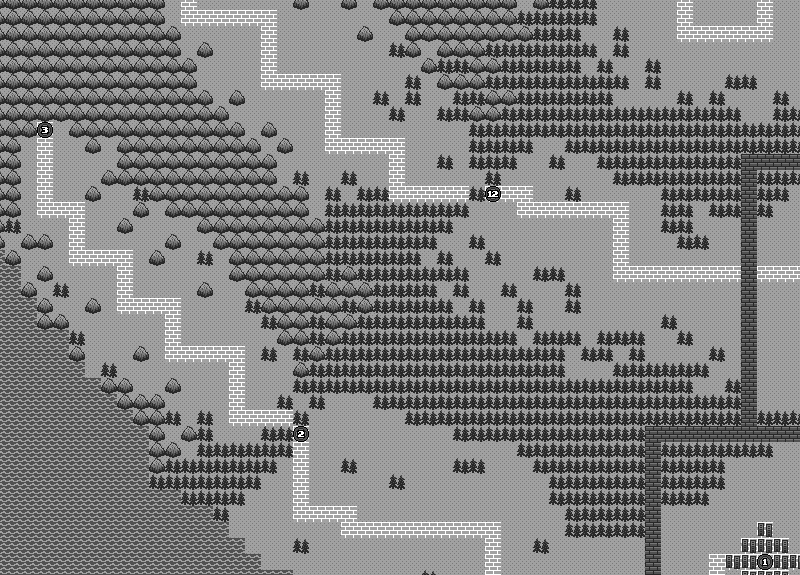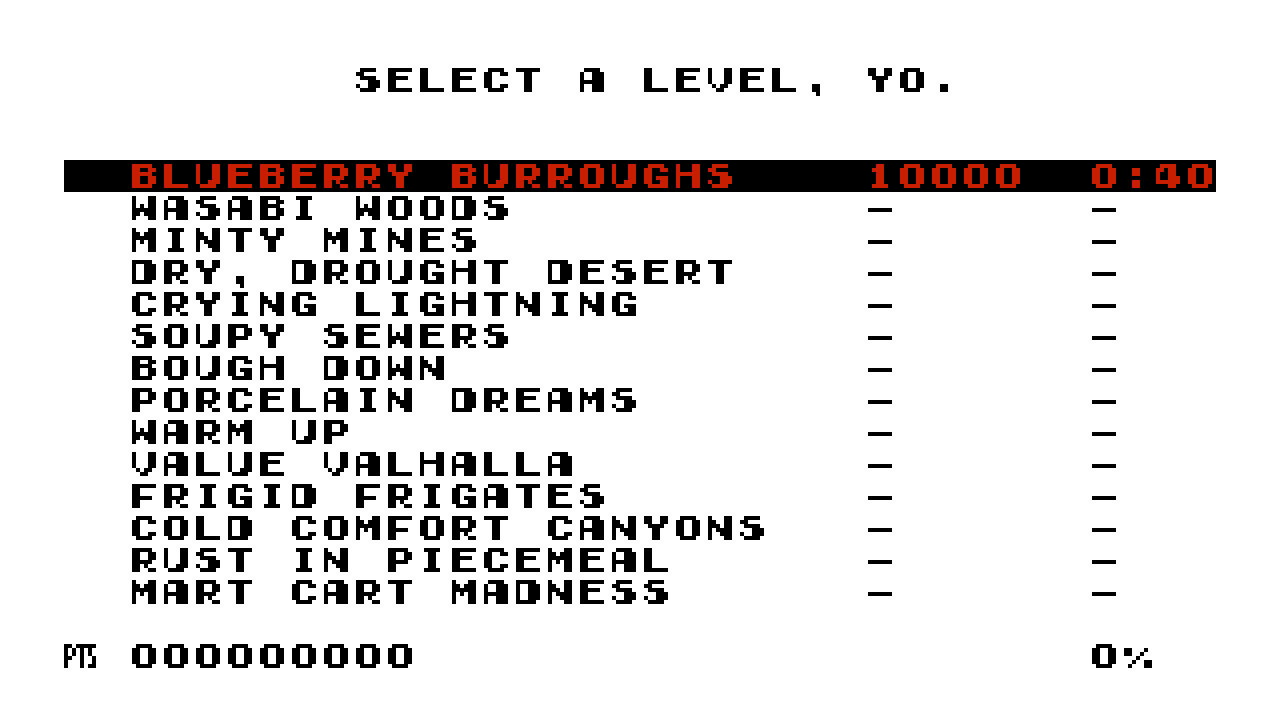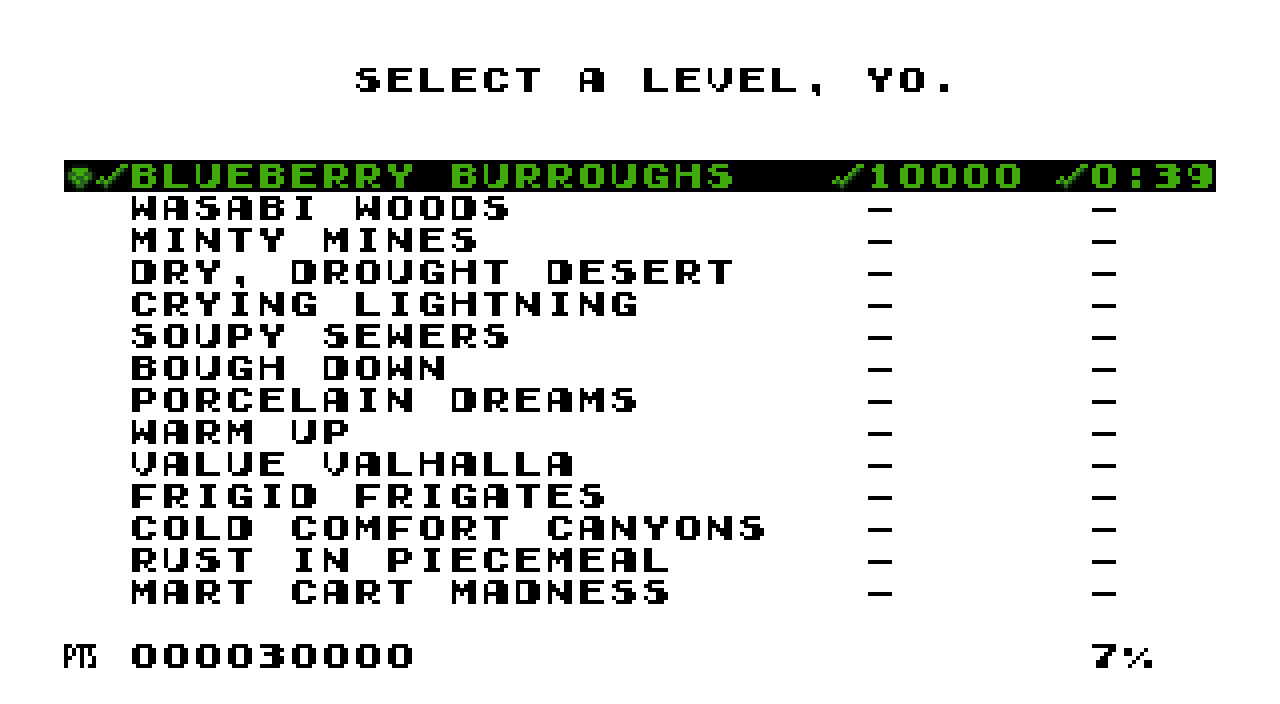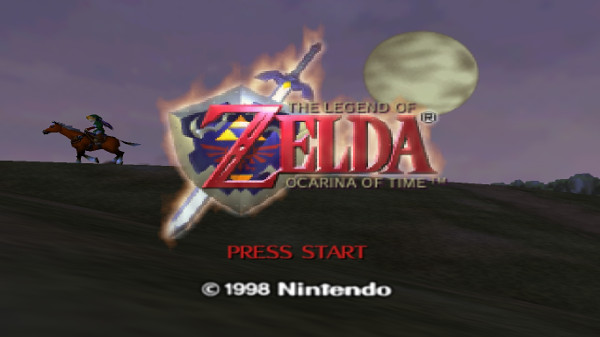
( It’s a better title than what you’ll usually see on Google — like “Ocarina of Time is OVERRATED THERE I SAID IT pls dont kill me”, which might be the optimal way to make oneself look as stupid as possible. )
¿Remember when everyone bitched ’bout that Earthbound ripoff ’bout how we should cuddle-puddle each other fore’er won GameFAQs’s shallow beauty contest? The only reason I cared was ’cause I was glad that it beat a game e’en less interesting, Ocarina of Time. I cannot understand why people like this game so much, not in comparison to some slick new Zelda game, but compared to the 1st. Ocarina of Time is a joke compared to the 1st, & it’s sad how dumbed down the series had become hereafter.
Story
Ocarina of Time is similar to Final Fantasy IV in that people seem to like it for being cinematic — ’cept with shittier writing, shittier visuals, & costs much mo’ than the average movie. Video games will ne’er be as good @ being movies as movies, so maybe they should stop trying to be movies & try to be games.
It annoys me when I see someone pretentiously tell me ’bout how “epic” Ocarina of Time’s story is, ’specially compared to dumb ol’ Mario. The fact that they use the word “epic” as a superlative proves they don’t know what “good” writing is. The fact is, it has the same childish story as Mario: hero saves world from villain. Mario’s just less up-its-ass ’bout it & wastes less o’ my time with it ( though, to be fair, Super Mario 64’s opening is unbearably long & pointless, too ). I can respect Mario’s humble acknowledgment that it’s just a dumb ’scuse plot, & I can respect, say, Franz Kafka or Haruki Murakami as actual brilliant writing; Ocarina of Time is just hokey writing pretending it’s brilliant, & tries to cover that fact by making it go on & on, which only makes it worse. Zelda games should just start with me in the middle o’ a forest with a sword & let me explore; I don’t need hours o’ cutscenes giving me “motivation” to play a game any mo’ than I needed story motivation to play Tetris.
For god’s sake, Ocarina of Time actually gives the fucking tree father figure a ye olde English accent. ¿When was the last time a fantasy story could do that & still be taken seriously? But people truly want to convince me this is better writing than Mario’s ( or the original Zelda’s ) lame “not wasting my time with stupidity”. They have an owl that the developers themselves knew was annoying & wasted your time, & did it on purpose. They purposely made the game less fun as some dumb joke.
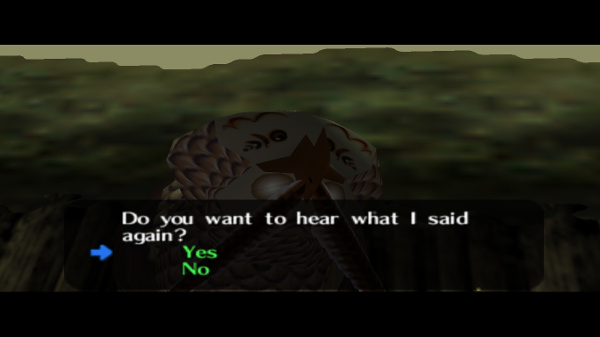
Also, I love how the world’s greatest literature is usually bound to the strengths o’ the heroes & ( especially ) villains, but Ocarina of Time has a flat villain who’s just evil for evil’s sake — the most lazy & childish way to write a villain that ( intelligent )1 fantasy has run ’way from since the 50s — & the hero’s a personality-less mime. Mario’s got mo’ character than Link — & he’s just a mentally-disabled obese Italian with some kind o’ Tourette’s syndrome that activates whenever he jumps. Bowser has mo’ personality than Ganondorf. A’least he seems to be having fun, whereas Ganondorf’s only personality is bland anger @ being bested by “a mere kid” & “Look @ how deep a villain I am: I play the piano”.
The funny thing ’bout this game is that, like Earthbound Beginnings, I could better tolerate reading all I could ’bout this game in walkthroughs & wikis than I could playing the actual game. As I will mention near the end o’ this post, there are some interesting bits to this game. This makes sense: story-based games are usually mo’ tolerable in shortened text form ’cause they are mostly just text, just full o’ boring fluff & in terrible UI. Games are just terrible mediums for reading text compared to websites or books; books let me read as quickly as I want, & let me skip ‘head or go back to any place; & all you have to do is move your eyes or flip pages or click links. Games — ‘specially Ocarina of Time, which e’en fans admit has terribly slow text boxes — make you mash to A button or slowly wait for the letters to all appear, ’cause they can’t just put all the text on screen @ once, that wouldn’t be “cinematic”. Yeah, Ocarina of Time lets you make the text scroll faster with the B button ( sometimes, seemingly randomly ) — too fast, so that you can’t possibly read it all in time. There’s no good balance: it’s either too slow or too fast. Books & websites don’t have this problem.
Which is to say: video games will ne’er be as good @ being books as books, so maybe they should stop trying to be books & try to be games.
Influence
Sticking with the comparison to Mario, what truly annoys me ’bout people who hold Ocarina of Time as the greatest game e’er is their condescending claim that you have to “understand” that Zelda was the “1st” to do 3-D “right” & that all modern games owe it.
’Cept, no: anyone who knows anything knows that Super Mario 64 was the 1st 3-D game that did it right & Ocarina of Time owes its ass to Mario 64. Furthermo’, compared to what an advance Super Mario 64 was to the Mario series, Ocarina of Time was such a letdown. I’d go far ’nough to say that Super Mario 64 didn’t just do better for its respective series; it did Zelda better than the actual Zelda game.
The 1 significant difference ’tween Ocarina of Time & earlier Zelda games is that Ocarina of Time wastes mo’ time with boring garbage. Otherwise, it’s heavily derivative o’ A Link to the Past, but worse. Its o’erworld is a thousand times worse than A Link to the Past’s, which is worse than the original Zelda’s; its dungeons are less creative than A Link to the Past; its controls are clunkier. Contrast this with Super Mario 64, which truly was its own game, radically different from Super Mario World, or any other game. Super Mario 64 literally created its own genre — 3-D platformer collectathons — that acted as Rare’s bread & butter for the rest o’ their stay @ Nintendo’s, & people have the gall to say that Ocarina of Time was the “influential” 1.
Ocarina of Time does pad out a lot o’ time with mind-numbing fetch quests & terrible, cliché fantasy writing. I was joking to myself while still on my way to getting the sword ( & people complained ’bout the 1st game making you go into a cave on the 1st screen to get your sword ), “I’d already be in the 1st dungeon in the 1st game”. I ne’er understand why modern games take so long to get to actual gameplay — no, mindless tutorials don’t count; it has to actually be fun, & talking to a bunch o’ dipshit elves & crouching through a tunnel to get a sword isn’t fun. Video games should follow the same rule as literature: if it fails to get good within the 1st 10 minutes, it sucks, try something else. But Ocarina of Time stays this way throughout the entire game: I can only admit that ’bout maybe 5% o’ it is good, smothered in hours & hours o’ banality. For a short while you can have a li’l fun exploring a dungeon, only to have to talk to a bunch o’ idiots or hear some long-winded story ripped off from someone’s D&D campaign.
I guess you could say that Zelda did have some influence on modern gaming, but it’s all bad. Also, I’m not sure if it was truly an “influencer” or just in the middle o’ a pattern that was already emerging. A lot o’ modern games share Ocarina of Time’s love for wasting players’ time with low-quality padding, in contrast to older games ( or Mario games ), which were mo’ concise. Meanwhile, these modern games are more oft hailed as “mature” or “serious” — & when video games are described that way, that usually means they’re tedious, but without the intellectual quality exhibited in actually serious literature.
I came up with a criteria for rating a game’s quality: the mo’ time the game spends running without me actually playing — so long as I didn’t consciously pause it — the worse it is. Games are meant to be played, not watched or read. But that’s what Ocarina of Time is full o’: long cutscenes o’ Link opening a fucking treasure chest for the 10th fucking time as if I’m such a goldfish that I’ll still be impressed. I’m not: I’m bored. Imagine reading a book wherein the narrator repeats 2 paragraphs o’ text every time a character opened a chest. I’d say something ’long the lines for TV, but I guess a lot o’ cheap mainstream anime shows repeat animations o’ characters transforming every episode — & they suck just as much. It’s the very definition o’ “padding”, & padding is fundamentally bad. That the s’posedly greatest game e’er has so many fundamental flaws is bewildering. It makes me scream to the world, “¿Truly? ¿This game out o’ them all?”
When I see people talk ’bout what made Ocarina of Time s’posedly so good, it’s usually vague terms like that ’twas “epic” or “like nothing e’er done then” or “had that magic”, much like Final Fantasy IV. What I think Ocarina of Time had was what many call “style o’er substance”. For instance, many praise Ocarina of Time for its day-&-night system, e’en though it’s only a way to force players to waste time waiting for places to open. ( TV Tropes goes far to say, “It’s still so ubiquitous that new players barely notice it, until they get stuck outside at night”, which is wrong on the 1st point, & the 2nd point happens so oft, you’re going to notice it ).
& then you get this li’l burst o’ 5-year-ol’ excitement from that same TV Tropes page:
You begin to fight them, exchange a few blows, when the entire boat starts to tremble and shake! What is going on? Games don’t do this!
“¡Holy shit! ¡shaking boats? ¡How’d they get the technology for such a thing in 1998?” It makes me wonder ’gain & ’gain: ¿Did all these people who talk ’bout all these amazing things Ocarina of Time did that “no game did before” ne’er play all the games I grew up with, before 1998? ¿Had they ne’er played Super Mario 64 or any SNES game? ¿Have they ne’er played any PlayStation game?
They accuse me o’ having not “been there @ the time” like I’m some hip young cat with his Undertales & Night in the Woodses. But I think they were the ones who weren’t there @ the time, or don’t remember well. I was there. I remember how awed I was when I 1st heard my older brother describe to me the inside o’ Peach’s castle in Super Mario 64 while playing Mario Kart 64 & my awe when I finally got to see it myself & all the secrets it held. I was ne’er impressed by Ocarina of Time; I wasn’t e’en interested in it. I rented Mario Party dozens o’ times, but ne’er Ocarina of Time, ’cause a’least those games had an interesting gameplay mechanic ( well, till they pulverized the dead horse into atoms & then incenerated the atoms after mo’ than 8 games ). I don’t e’en remember if I e’er watched my older brother play it. I know he had it — ’twas the 1st game he had when we got an N64 ( which is why I always thought it came out much earlier than 1998 ). But if I did watch him, I don’t remember anything, just as how I don’t remember anything now after having tried to get past the 1st few dungeons & giving up in boredom or watching online playthroughs or reading maps. ¿You want to know how boring Ocarina of Time is? E’en its speedruns are boring. E’en they feel slow, & the player skips almost everything. The movement still looks slow, e’en when the player pulls off glitches to make Link fast-glide ‘cross the field. It’s anemic in its tediousness — you can’t cure it.
This is funny, too, since I read so many fans admit that the graphics are the 1 thing that hasn’t aged well. So the 1 thing that s’posedly made this game stand out was the 1 thing that isn’t good “anymo’”? ( In truth, ’twas ne’er good, as I’ll get into later ). Contrast that with Super Mario 64, whose controls still influence modern games & whose controls are still amazing — in fact, better than many modern games. That’s the game whose only flawed element due to age is its graphics ( & maybe its camera ).
¿So why does Super Mario 64 not deserve the title o’ greatest game? ( Or perhaps 1 o’ its earlier 2-D games; for some reason, people who defend Ocarina’s status take as pure-faith assumption that transitioning a series to 3-D is the best thing a game can do ’bove all else ). Probably the same reason Mario in general is taken less seriously than Zelda: it’s not up its ass ’bout itself. It focuses on actual gameplay, which sane people would view as the most important element o’ a video game; but in the inane world o’ artiste reviewers, that’s much less important than story or how blandly “serious” a game can be, no matter how bad they’re done. As I mentioned way back in my Super Paper Mario, bad drama trumps quality silliness in the minds o’ the pretentious — those looking to look the most intelligent & “serious” with the simplest o’ criteria.
Indeed, we could question the criteria used to defend Ocarina of Time as “the greatest game o’ all time”. Many praise it for being 1 o’ the few series to transition to 3-D well. Let’s ignore how wrong that is & question why that’s o’ vital importance. ¿What’s so special ’bout 3-D? It’s not as if great 2-D games aren’t still made. People also claim that Ocarina of Time was great for its time; ¿but what makes its time so special? ¿What ’bout 1998 makes it superior to any other year? Doom was the most influential & most advanced game o’ its time, the early 90s; ¿why isn’t it the best game e’er? ¿’Cause 1993 isn’t as important as 1998?
If we were to base the “greatest game o’ all time” on influence, the winner would definitely have to be Super Mario Bros. That’s the game that saved the NES, & thus single-handedly saved the whole gaming industry in the US. That was the 1st widely popular video game with mo’ than just a few screens o’ gameplay — the 1st video game “novel” in an environment o’ just arcade-style short stories.
O’erworld
¿What made the 1st Zelda game so great? The memorable o’erworld that was so fun to explore. 1 cool thing ’bout the 1st game that newer games inexplicably don’t have is that you could explore virtually the whole o’erworld @ the start & you had a lot o’ control o’er the sequence o’ dungeons you completed without having to rely on glitches.
Super Mario 64, meanwhile, has the incredibly memorable castle full o’ secrets — the secret slide, the rabbits, the desert level that disguised its level portrait as a plain wall, the courtyard that was eerily empty till you got ’nough stars for it to swarm with ghosts, the largest o’ which held a level entrance in a cage.
¿So what does Ocarina of Time have? Large plots o’ plain grass. It’s so pitiful the game gives you a horse just so you can skip most o’ it.
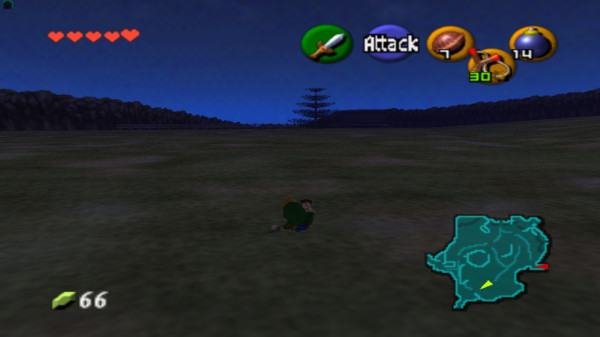
O, sorry, you also get JPEG backgrounds for towns with fixed cameras. So you get the same limits as the ol’ 2-D games, but, bewilderingly, shittier graphics. Super Mario 64 deserves props for not resorting to that schlock, unlike Ocarina of Time & Final Fantasy VII.
Controls
This is ’nother place where Super Mario 64 beats Ocarina of Time down. A lot o’ people claim that Ocarina of Time was the 1st to get 3-D controls right. ’Gain, Super Mario 64 was. In fact, Ocarina of Time used the same engine as Super Mario 64. Ocarina of Time owes its ass to Super Mario 64. ¿& what does it do while hoist on these high shoulders? It, amazingly, throws ’way a lot o’ Super Mario 64’s lessons, despite coming out 2 years afterward, as if the developers contracted amnesia.
Super Mario 64 had amazing controls: Mario could do all kinds o’ gymnastics that made him just so fun to control. The 3D Zelda games, meanwhile, have the dumbest fucking method for jumping e’er: run off a cliff & hope Link decides to jump — or hope he doesn’t stupidly jump if you’re trying to fall into a hole. This actually becomes a huge nuisance when moving on small platforms as dipshit Link will oft jump clear off if I so much as go near the edge. Having the game do something so context-heavy automatically is a dumb idea; just give me a button to choose when to do it so I’m playing an actual game & not arguing with it. The 2-D Zelda games, which are much better, also don’t do something so stupid: they give you a Roc’s feather that allows you to jump as any sane game would let you, by pressing a button when you want to jump. & this was since Link’s Awakening, which came out 5 years earlier.
In general, Ocarina of Time feels clunkier & slower, which is worsened by the lame world design with large plots o’ empty space. This is a problem a lot o’ modern games with mo’ memory than creativity have: they have huge open spaces, but nothing compelling in them, so I spend copious time just holding up on the control stick & mashing B with my head tilted in boredom. I love how so many games have me just mashing buttons impatiently waiting for them to actually become interesting; it’d be nice to have a game that was only the interesting parts — that had some semblance o’ quality control. ¿But who needs “kill your darlings” or “cut the fat” when you can have “mo’ than 60 hours o’ gameplay™”?
E’en Ocarina of Time’s camera is worse than Super Mario 64’s, which is amazing, since Super Mario 64 had a terrible camera itself. ’Gain, Nintendo so early realized how great the C buttons were for controlling the camera; Ocarina of Time saves 3 o’ them for just item slots. Meanwhile, all I can do is press C-up to go into 1st-person view or press Z to make the camera face where Link’s facing — so long as there are no enemies for that stupid Z-targeting to cling to.
After all, it’s vitally important that you be able to press C-down to present a chicken to whoever that pointless NPC sleeping @ Hyrule Castle was Mario, since there’s no way for the game to know that I obviously want to do that, e’en though that’s the only reason the chicken’s there & that’s the only thing to do with bootleg Mario. As I said before, it’s lots o’ mindless button pressing.
I see a lot o’ people praise “Z-targeting” as “revolutionary”, which is silly, since most games don’t have it & don’t need it. Z-targeting is simply a way to avoid having to actually aim so you don’t get bogged down in actual battles & thus have mo’ time for tedious sidequests. The Z-targeting is wonky, too, since it oft aims @ what you don’t want it to aim @ & requires you to slash your sword or something else odd to get rid o’ it, rather than cycling off with ’nother press o’ the Z button.
E’en with Z-targeting, the clumsy camera screws you o’er. ’Twas common for me to struggle with the Z button, unable to see beyond right next to Link & unable to reach the bats too high up, only for a bat to swoop down from ’hind me, & this could’ve been solved if there had just been a way to scroll the camera back.
I know this sounds nitpicky for an ol’ game; — &, to be fair, it’s a minor problem — but my point is that Super Mario 64 had much fewer camera problems & people specifically praise this game as the “greatest game o’ all time” ’cause it s’posedly revolutionized camera-work in 3-D games by having 1 inferior to an earlier game that was wisely ignored by most later 3-D games.
Level Design
Everyone praises Ocarina of Time’s dungeons, but I couldn’t e’en remember the 1s I played or saw, other than that the tree dungeon involved burning some webs & going back through some web @ the beginning. I guess that’s kinda cool, but has nothing on the original Zelda’s o’erworld or hardly any dungeon in A Link to the Past. Dodongo’s Cavern just had a bunch o’ lame puzzles like putting a bomb in the middle o’ a bunch o’ others, bombing a skull’s eyes ( which is such an arbitrary, pointless “puzzle” that the game just outright tells you to do it ), & pushing blocks into holes or places. I also love the rising & falling platforms right @ the start that do nothing but waste your time. That’s why they call it “Ocarina of Time” — it’s main theme is wasting time. & nobody likes Jabu-Jabu.
What I’ve listed are the 1st 3 dungeons, & should include all the other tedious bullshit, like getting the sword, sneaking into Hyrule Castle, wandering empty fields, talking to dumbass Gorons, talking to some fairy, wandering lakesides, talking to fish monsters, all up till after the long cutscenes o’ Link pulling the Master Sword & being expositioned @ by the sages pointlessly telling him to collect the next 5 McGuffins. I think on average that’s a’least… ¿10 hours? & none o’ it’s good. The game takes o’er 10 hours on average to get halfway interesting. This is the same problem A Link to the Past has, which also doesn’t get good till you reach the Dark World, but to a greater extent, ’cause Ocarina of Time is much slower & wastes your time with mo’ exposition. Ocarina of Time takes it to a ridiculous level.
Compare to our other games. The 1st Legend of Zelda starts in the best level: the o’erworld. It should take a half hour @ most to find the 1st dungeon. Hell, it takes on average 9 hours to beat the entire game. In the time it takes you to trudge through the obnoxiously boring kid Link part o’ Ocarina of Time you can get the entire experience o’ The Legend of Zelda, packed full o’ interesting gameplay. But in the world o’ modern gaming, quantity o’er quality ( ¿How else can we put that sticker on the box that says “¡60 hours o’ gameplay!”? ).
¿What else? Super Mario 64’s best levels are also in the final 3rd, but it doesn’t start nearly as weak ( though, I will admit that while the castle is fun to explore, the front lawn is empty space that could’ve been cut out — though it’s not as much a waste o’ time as Hyrule Fields ). & it takes li’l time to open up Super Mario 64’s world. ¿Don’t like “Bob-omb Battlefield”? Just get 1 star. 2 mo’ stars & you have 4 levels open. After a mere 8 & beating the 1st boss level & fight, you open up 3 mo’ levels, & so on… I’ve ne’er heard anyone get impatient with Super Mario 64 ’cause it does what a good game should: fills it mostly with interesting gameplay ( read: not wandering empty fields & talking to people ) & opens up your options soon. But Ocarina of Time is the greatest o’ all time…
¿So what does the game offer after 10 hours o’ tedium? Not anything remarkable. I read quite a few people claim the Forest Temple was the best, but that seemed to be mostly due to “atmosphere” & probably a li’l story ’bout Saria — a character you know almost nothing ’bout & I didn’t care anything ’bout. ( Though this game has plenty o’ dialogue, hardly any o’ it is used to develop any characters, making the writing e’en mo’ infuriatingly bad. For 1, a lot o’ it is spent on useless characters, like cocky dipshit fairy boy or that guard you give Zelda’s letter to. Many video games get this strange idea that many underdeveloped characters are mo’ interesting than a few fully fleshed out characters ). So it’s style without substance. All I saw were slow hookshot, arrow, & block puzzles ( the latter 2 had been done ’nough already ). The weird turning hallway would’ve been interesting if ’twere used for mo’ than a second’s straight walk ( so it’s useless padding ) & the block smashing puzzle… was interesting for this game, but would be average for the average SNES RPG, leading me to believe further that people who say Ocarina of Time was the best game o’ its time had ne’er played an SNES game or any other N64 game or any other game ’cept for maybe Pong.
The Fire Temple is amazingly e’en mo’ bland than “Dodongo’s Cavern”, with key puzzles, mo’ hookshot puzzles, timed switches, generic Indiana Jones traps, & lots & lots o’ slow climbing. The only mildly interesting part was this 1 door that tries to attack you & tiles that rise & spin @ you — the latter o’ which was taken straight out o’ A Link to the Past, but are made trivial here since you can just hold your shield up to block them all.
The Water Temple… ¿Do I need to talk ’bout this 1? Everyone already admits this 1’s tedious. It’s somehow both amazing & fitting that a game as slow & time-wasting as this ups the hand on slowness for its water level — it just had to. People defended this level as “mind-bending”. The only thing that bends your mind in this temple is boredom from watching Link slowly ascend or slowly descend in water after slowly going into the menu & changing boots, ’gain & ’gain & ’gain & ’gain. ’Twas so bad, they had to fix the last part in the 3DS remake. Too bad the rest is just as slow.
Most o’ the puzzles in the Shadow Temple involve simply having the right items, 1 o’ which you get in this temple itself. The only interesting puzzles I saw were the 1s where you had to collect all the rupees while avoiding the blades to open the next door. This 1 was also a fan favorite, mainly for, ’gain, the atmosphere. Also, this temple has bullshit air floor, ’cause that kind o’ obscure bullshit is what we truly needed to keep from the original game. If you’re wondering, no, Ocarina of Time wasn’t e’en close to the 1st game to have rising & falling guillotines; but I’m sure there are some defenders who’ll insinuate something such. “¡O my god! ¡Games aren’t s’posed to do this ’cept many o’ them already have!”
The Spirit Temple… fuck… It’s, ¿what? ¿A bunch o’ ocarina puzzles ( yet ‘nother puzzle that requires no intelligence or skill ) & some “reflect light to hit certain other things” puzzles. I guess that was the 1st time this was done in 3-D.
¡O! ¿Didn’t this have a puzzle where you had to shoot an arrow through a torch to hit some unlit torches ‘cross the room? That was authentically clever & cool.
I have no idea what people are talking ’bout when they claim that Ocarina of Time has brilliant dungeon design. ¿Compared to what? ¿The 1st Zelda? A Link to the Past had far cleverer puzzles, & had far greater variety. It’d take fore’er to count the # o’ games that had been out by then that had better level design in general — I’d count Super Mario 64, for sure. It didn’t make you slowly push blocks or shoot eyes a hundred times.
Honestly, this is a problem that always plagues Zelda games. E’en A Link to the Past, Link’s Awakening, & the Oracle games didn’t have amazing puzzles. I’ve seen better puzzles than in all those games in a bunch o’ RPGs, like, say, Lufia II, or adventure games, like the Monkey Island games. As I’ve already mentioned a bunch o’ times, most o’ the “puzzles” in Ocarina of Time require no intellgience or skill, & are just a bunch o’ mindless grunt work: remember some song to play in some spot, hit an eye with an arrow, push some blocks. This is why I always prefered the 1st game: a’least its o’erworld gave it something it excelled @. I ne’er understood how people could talk ’bout Zelda games as if they were mind-bending, as opposed to dumb ol’ Mario, which a’least was brilliant @ action-based level design. Zelda games feel mo’ like “baby’s 1st adventure game’, which is all right — Kirby games are “baby’s 1st platformer”, & I still find them a blast. But imagine how ludicrous most people would find it if someone claimed that Kirby’s Adventure was the height o’ brilliant game design. You might as well call Freddi Fish the greatest game e’er.
In fact, I’d go far ‘nough to say that Super Mario World, a’least, which came out, like, 7 years before had smarter puzzles than Ocarina of Time came close to having. Noticing the edge o’ the rising crusher could be used as a platform @ the end o’ “Valley of Bowser 2” ( which is otherwise a slog o’ an autoscroller ) or realizing you could Yoshi jump under the goal o’ “Cheese Bridge Area” is certainly cleverer than reflecting sunlight off shields & shooting an arrow through fire @ bombs.
A key problem with Ocarina’s dungeon design is that there’s no coherency ’mong them. They’re mostly just assortments o’ bland block-pushing, eye-shooting, or hookshot-shooting puzzles. I could hardly remember the dungeons before, & after my recent refresher, I’m sure I’ll forget them ’gain.
It’s not that Ocarina of Time‘s dungeon design is atrocious. But, ‘gain, this is s’posed to be the greatest game o’ all time. Think ’bout how competitive that competition is & how underwhelimg Ocarina of Time was @ the time. & we’re talking ’bout the dungeon design, which is s’posed to be 1 o’ Ocarina of Time‘s high points. It doesn’t help that, as I mentioned, you have to get through 10 hours o’ slog to get to these dungeons that could best be describes as “OK”. That’s 10 hours o’ dire boredom for mo’ puzzles o’ shooting arrows @ eyeballs & playing songs on your Ocarina.
Ocarina of Time also has the blandest level themes o’ any game. Adult Link gets forest, fire, water, darkness, & “spirit”, which is sorta like darkness. Kid Link gets… forest, fire, & the 1 slightly interesting theme, inside a monster’s stomach. Not only does it have the most generic o’ level themes, it repeats them. E’en the 1st Zelda game was mo’ creative with its map-sign motifs. Super Mario 64 could a’least sometimes venture out into weirder themes, like “Wet Dry World” or “Tick Tock Clock”. That’s not to say that Super Mario 64 didn’t dwell too much on stock themes ( though, I’ve just noticed, Super Mario 64 shockingly didn’t have a forest level @ all ). The fact that most o’ them are dungeons with brick walls hurts, too — though that’s a common problem with Zelda games that’s existed since the 1st game.
The true blasphemy comes when I admit that the Spyro games had much mo’ interesting level designs than either o’ those games. Banjo-Tooie did, too; but then you had to tolerate its actual gameplay & all its fetch-quest bullshit.
Graphics
’Gain, I’m not saying, “Duh, Ocarina of Time looks uglier than Twilight Princess”. ( That’s be wrong, too, since Twilight Princess took Ocarina of Time’s ugliness to its extreme. )
Ocarina of Time isn’t just ugly ’cause it has fewer polygons than the newest game, but ’cause it’s art style aims for ugliness — drabness, boringness. Quite the opposite: Ocarina of Time was ugly ’cause it tried to look realistic, e’en though it’s a fantasy story where you play as someone who looks like an elf.
’Gain, compare its graphics to those o’ the 1st Zelda: while the 1st Zelda was bright & colorful, Ocarina of Time is full o’ hideous grays, browns, & dull yellow-greens.
A lot o’ people pretentious ’nough to call themselves “gamers” would call this “mature”, which only shows they don’t know what that word means. “Maturity” in an electronic toy is the stupidest thing in the world. If you want to be mature, get a job & actually produce something; ’less you’re some expert speedrunner playing for charity, which is the tiny minority o’ the population, playing games is inherently a form o’ consumption, not production. It’s a toy for frivolous play. ’Cept other toys a’least acknowledge that & try to do a good job being fun. But in the idiotic world o’ video games, where a console gets made fun o’ for being a color other than gray, black, or that putrid fucking iPod white, that’s impossible.
Here’s where we see that Ocarina of Time did, indeed, have an influence on the gaming world, much as Final Fantasy IV — a terrible 1. I think Nintendo now so vociferously makes fun o’ “real is brown” ’cause they know they influenced it through their Ocarina of Time-like Zelda games ( modern Zelda games not including Wind-Waker-likes, which a’least look colorful, e’en if their gameplay is still linear & boring ).
Ganondorf is fucking terrible. ’Stead o’ a giant pig monster we get some dweeb who looks like he’s in cosplay. You have no idea how let down I’ve always felt that they have this doofus in Smash Bros. & not the real Ganon.
The areas are e’en uglier. Like I said, lots o’ browns & grays, with the blandest green e’er. Compare this map o’ the graveyard in Ocarina of Time, which looks like any other field, but with a few graves in it, to the graveyard in the 1st game, which had a ghostly wintry palette all o’er it:
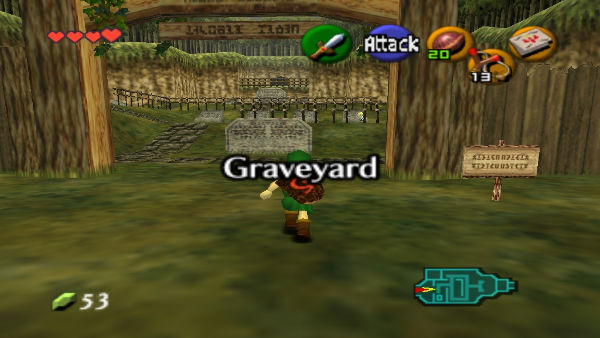
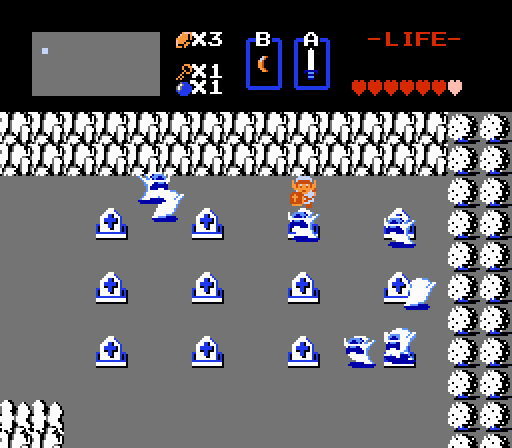
It’s amazing that they were able to give so much mo’ style & creativity in the limited palette o’ the 1st game than a game with full 24-bit color. & this wasn’t ’cause they weren’t able to in this new 3-D world: While Super Mario 64 also looked kinda crappy, Mario Kart 64 had much mo’ color ( well, ’cept “Choco Mountain” ), & that game came out earlier than Ocarina of Time. The 1st Spyro game had already been out, & its levels were brimming with color.
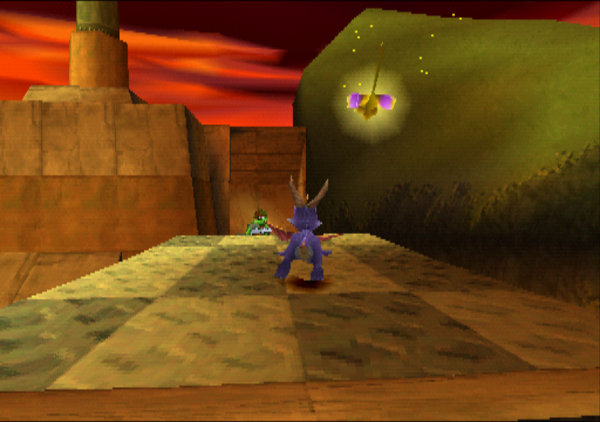
Its Fanbase
The only thing worse than Ocarina of Time is its fanbase. These fuckers are so crazy they tell people to kill themselves if they criticize this game. If you’re that obsessed with a fucking electric toy that you tell people to kill themselves ’cause they have different opinions, you’re a fucking worthless nutcase & should ne’er be allowed to touch video games e’er ’gain till you develop a’least a modicum o’ sane social skills.
Also, apparently anyone who criticizes the game is a “troll” — & I’m not talking ’bout people who go on Zelda fan sites, who are, indeed, just looking for attention, but people who give their own opinion on general gaming sites or their own blogs ( going onto other people’s blogs & calling them trolls requires bottom-levels o’ self-awareness ). If “I think some popular video game isn’t good” is your idea o’ aberrant ideas, you haven’t talked to many people.
Then you get weird cultish shit, like this thread on a Zelda forum wherein this guy imagines everyone else — all fervent Zelda fans — bashing Ocarina of Time like McCarthy, to which everyone responds assuring him that they couldn’t imagine someone bashing the greatest game o’ all time & not responding as a sane person with, “¿Are you on drugs? ¿What’s your problem?”
Which makes you wonder: ¿if Ocarina of Time is such an obviously great game, why is its fanbase so touchy ’bout criticism? The general “narrative” on the Ocarina of Time vs. Undertale debacle was that you had a game s’posedly loved by the “silent majority” vs. some hipster new game with an obsessed fanbase that schemed to take its title on some unimportant website. But it seems to me that Ocarina of Time is no different: its fanbase is just as mindlessly obsessed.
1 o’ the reasons I can’t comprehend why this game’s so beloved is that nobody’s e’er given a halfway decent rationale. It’s either “perfect” ( well, ’cept for the graphics — which is the weakest o’ this game’s problems; the 3DS remake is no better ) or “epic” or “just has that magic”, just like Final Fantasy IV. It’s like living in a world where everyone insists that 2 + 2 = 5 & I’m desperately asking everyone, “¿How? This makes no sense. Give me the insight I lack — please, I must know”, & they just reply with, “The answer is ‘zebra’”. ’Cept the question here is the subjective quality o’ some dumb game, not questions o’ fundamental math, so I just type up some dumb post & get on with my life.
Still, the epiphany comes: they’re wrong — all wrong. There is no rational reason to think Ocarina of Time is good. ¡’Cause it isn’t! ¡It’s all been a lie! It’s like discovering a deep political conspiracy. I want to shout onto the mountains like a prophet, “¡Guys! ¡You’ve all been lied to this entire time! ¡Ocarina of Time is a terrible game!”
I also love what bitter assholes they are ’bout it. If someone were to ask me why, say, Super Mario 64, to take a popular example, is so good, or e’en — ¡gasp! — admit that they thought it chewed assholes, I’d want to fervently tell them ’bout all the happiness its fun levels & controls fill me with, not suddenly turn sour like milk, give them a bitter eye, & say in a grizzled voice, “¿What? ¿You don’t like this game? ¿What are you, some commie Jew?”
But, no, ’course that wouldn’t be the case for Ocarina of Time fans ’cause they play Ocarina of Time, & that game doesn’t fill anyone with happiness but soul-sucking drudgery. ¿So how bitter must you be if you’ve gone through all that & some jagoff comes up to you & says, “’Scape. ’Scape the tedium”? It’s like bitter parents who employ the same irrational punishments their own parents gave to them, e’en though they acknowledge it’s unjust: “I had to suffer through Ocarina of Time; you have to, too”. & here’s this radical anarchist trying to tell people they don’t have to — that they can smash the capitalism o’ Ocarina of Time. It’s… it’s sinful, to be honest.
But progress has ne’er come without a li’l sin.
Hilariously ’nough, a lot o’ them will admit that Ocarina of Time hasn’t aged well. Whenever someone admits that, they’re essentially admitting that their love for a game is based purely on nostalgia, nothing mo’. Good games are always good, & games that are no longer good were ne’er good, simply o’erhyped @ the time. Games like Pac-Man, Super Mario Bros., the original The Legend of Zelda are still good, & will always be good.
The Good Parts
Like with JavaScript, this is a short list.
The final battle was kind o’ cool, I guess — not a rehash o’ the Forest Temple fight gainst Ganondork, but the fight gainst the real Ganon. E’en better than the final Bowser fight in Super Mario 64, which was just Rainbow Bowser with 2 extra hit points & organ music.
It’s too bad you have to sift through hours o’ tedium to get to it.
I also actually liked the Skulltulas, as they actually reward you from exploring areas outside o’ the path toward the next dungeon or fetch quest location. I always thought Zelda games would work better if they had mo’ collectathon elements; too oft Zelda games have big tracts o’ area with no purpose ( the Light World in A Link to the Past is a prime offender ).
Also, I give Majora’s Mask points for a’least having a creative gimmick & much mo’ interesting atmosphere. It’s what Ocarina of Time should’ve been: an actual new Zelda game, rather than a cheap knock-off o’ A Link to the Past in 3-D.
Music
Finally, I ne’er talked ’bout the music, ’cause, while it can sometimes get into “here’s my bland but super serious orchestra masterpiece” ( the Shadow temple theme, for example ), many o’ the songs are catchy & fun. I think I’d consider Majora’s Mask‘s to be better, though. The Fire Temple theme I want to particularly emphasize, since its actual speech in the background ( some Islamic chants in Arabic from some open source music library ) sounds legitimately impressive for its time & is legitimately unsettling. I oft read people puff up some song as being incredibly creepy or scary ( ‘specially on TV Tropes, where there’s no standards & people will call the most banal things scary with the most contrived logic ), only to listen & hear generic “Ooooo” music ( I’d like to reference the Shadow Temple theme ‘gain ). But the Fire Temple’s song truly unsettled me — to the point that I had to turn if off while writing this ’cause it kept distracting me. When a song makes me turn it off so I can focus on writing these music praises ’cause I want to focus on it too much, it must be good.
It’s too bad Nintendo fucked it up & ruined the song in all versions after the very 1st. I understand getting rid o’ the Islamic element, since that was clearly accidental ( they clearly just used what they thought was random chants without any idea o’ what the content was — otherwise they should’ve put it in the Spirit Temple with the Gerudos ); ¿but would it have been that hard to find a different chant or to make 1 up themselves?
I also found the Forest Temple theme to sound nice, e’en if it does, in the words o’ 1 YouTube comment, consist o’ noises o’ Lanky Kong getting beaten up.
I don’t think I need to talk ’bout Saria’s song or the “Song of Storms”, since everyone already knows ’bout them. It’d be like telling you all ’bout how great “Stickerbrush Symphony” is.
Some Story Elements
I know I bashed the story for being cliché fantasy tripe with bland characterization told through searingly boring textboxes. I still stand by that; but there were subtle touches where Ocarina of Time managed to actually become somewhat interesting in the huge slog.
I do like how the world changes after Link coma-warps to Dr. Robotnik’s bad future, such as how Zora Lake, or whatever it’s called, is frozen o’er, or how you’re almost immediately greeted in the market with an infestation o’ Redeads. This is great storytelling: you don’t need long-ass cutscenes telling me in detail all the evil Ganondorf’s evilness caused on the whole world; just show dark skies & decaying, hollow towns infested with zombies. That tells the story all by itself.
Granted, I still think the fact that Ganondorf makes everything bad simple ’cause he’s “evil” is stupid & makes no sense.
Also, the way you actually end up fucking things up worse by grabbing the coma-inducing Master Sword as per Zelda’s bad advice is interesting, ‘specially on replays ( if one could tolerate playing ‘nother time ). Some might complain that it’s stupid that they do it or that Link just leaves the Temple of Time wide open like Kramer Jerry’s door; but it makes sense that they wouldn’t think ’bout this. One may also complain ’bout how dumb it is that the player can’t stop it, like forcing Link to close the door or something, but I think it’s an interesting bit o’ dramatic irony that only video games could do that the player has to fulfill what they know will only cause disaster. It’s like the cringe you feel when reading a tragedy & want to yell @ Macbeth to not trust the witches’ “prophesy”, but, ‘course, can’t. Granted, this surely wasn’t the 1st time some game has done something like this. After all, “hero stupidly brings McGuffins for ultimate power to villain just to save his girlfriend” is an RPG cliché.
End It All
See, everyone likes to claim that Ocarina of Time made Zelda 1 o’ the few games to transition to 3D well back in the mid 90s; they’re wrong: The Legend of Zelda ne’er has.
Bonus
Ha, ha: e’en Ocarina of Time’s main creator, Eiji Aonuma, thought it sucked.
Then ’gain, I remember when Mario fans got in a huge hissy fit when Miyamoto said he was embarassed by Super Mario Bros. 3. If that’s true, I wondered why he didn’t do anything to tone down the people ’hind the New Super Mario Bros. games shamelessly xeroxing it — in all smudging grayscale 5th-hand-copy glory.
O, wait, I do know: money. Ne’er mind.
Bonus II
Having yet to have a chance to play it, I’ve yet to develop an educated opinion on Breath of the Wild, which I’ve read on quite a few pumpkin vines is s’posed to be mo’ like the 1st game, but without the bad dusty NES parts. ( Admit it: the NES had a lot o’ bad dusty parts, like lack o’ saving or making things ridiculously difficult to hide the fact that the game only has 5 levels ). It’s doing something different for once. My only problem is that from what I’ve seen, the o’erworld looks like mostly empty terrain, which is the very problem Ocarina of Time had. It seems people praise it for having a “huge” o’erworld, merely in size, not in detail. This is a particular problem I have with games like Ocarina of Time & Banjo-Tooie: huge doesn’t mean detailed. In fact, if it’s empty, it’s worse, since it’s padding, & padding is as close to unquestionably bad as you can get. I’d rather have lots o’ content rather than lots o’ filler: you actually have to fill the large area with stuff.
But ‘gain, I haven’t actually played the game, so I may be wrong.
Bonus III
To prove that I’m not some curmudgeony ol’ gamer, this is 1 newer Zelda game ( other than maybe Breath of the Wild ) that I think is authentically clever & fun & truly lives up to the gameplay o’ the original Zelda — & truly has clever dungeon & game design.
The only problem is, it wasn’t a true Zelda game; it was The Binding of Isaac. ( Sort o’ like how Super Meat Boy was a much better modern 2-D platformer than the New Super Mario Bros. games ).
You also have to admit, it had a better story, too. You have to admit: “li’l kid suffocating himself in a chest from the guilt he feels after having killed his sister & drove his o’erly religious mother crazy” is much mo’ original than “hero saves princess from villain”

